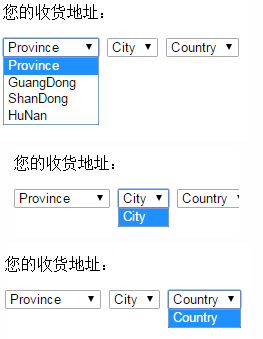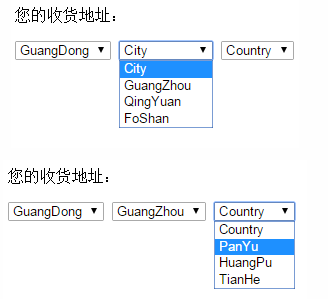Heim >Web-Frontend >js-Tutorial >Natives JavaScript implementiert dynamische dreistufige Verknüpfungs-Dropdown-Menüs für Provinzen, Städte und Landkreise. Beispielcode_javascript-Fähigkeiten
Natives JavaScript implementiert dynamische dreistufige Verknüpfungs-Dropdown-Menüs für Provinzen, Städte und Landkreise. Beispielcode_javascript-Fähigkeiten
- WBOYWBOYWBOYWBOYWBOYWBOYWBOYWBOYWBOYWBOYWBOYWBOYWBOriginal
- 2016-05-16 15:16:221730Durchsuche
Genau wie bei der Auswahl einer Einkaufsadresse wird die Städteliste dynamisch über die ausgewählte Provinz und die Kreisliste dynamisch über die ausgewählte Stadt geladen, sodass die dreistufige Verknüpfung von Provinzen, Städten und Landkreisen möglich ist Im Folgenden wird natives JavaScript verwendet, um diese Funktion zu implementieren:
Lassen Sie mich Ihnen zunächst die Testergebnisse zeigen:
Wenn keine Auswahl getroffen wird:

Bei Auswahl:

Der Code lautet wie folgt:
<!DOCTYPE html>
<html>
<head lang="en">
<meta charset="UTF-8">
<title>三级联动测试</title>
<script src="jquery-2.1.4.min.js"></script>
<script type="text/javascript">
//用来获得option元素中selected属性为true的元素的id
function Get_Selected_Id(place){
var pro = document.getElementById(place);
var Selected_Id = pro.options[pro.selectedIndex].id;
return Selected_Id; //返回selected属性为true的元素的id
}
//改变下一个级联的option元素的内容,即加载市或县
function Get_Next_Place(This_Place_ID,Action){
var Selected_Id = Get_Selected_Id(This_Place_ID); //Selected_Id用来记录当前被选中的省或市的ID
if(Action=='Get_city') //从而可以在下一个级联中加载相应的市或县
Add_city(Selected_Id);
else if(Action=='Get_country')
Add_country(Selected_Id);
}
//用来存储省市区的数据结构
var Place_dict = {
"GuangDong":{
"GuangZhou":["PanYu","HuangPu","TianHe"],
"QingYuan":["QingCheng","YingDe","LianShan"],
"FoShan":["NanHai","ShunDe","SanShui"]
},
"ShanDong":{
"JiNan":["LiXia","ShiZhong","TianQiao"],
"QingDao":["ShiNan","HuangDao","JiaoZhou"]
},
"HuNan":{
"ChangSha":["KaiFu","YuHua","WangCheng"],
"ChenZhou":["BeiHu","SuXian","YongXian"]
}
};
//加载城市选项
function Add_city(Province_Selected_Id){
$("#city").empty();
$("#city").append("<option>City</option>");
$("#country").empty();
$("#country").append("<option>Country</option>");
//上面的两次清空与两次添加是为了保持级联的一致性
var province_dict = Place_dict[Province_Selected_Id]; //获得一个省的字典
for(city in province_dict){ //取得省的字典中的城市
//添加内容的同时在option标签中添加对应的城市ID
var text = "<option"+" id='"+city+"'>"+city+"</option>";
$("#city").append(text);
console.log(text); //用来观察生成的text数据
}
}
//加载县区选项
function Add_country(City_Selected_Id){
$("#country").empty();
$("#country").append("<option>Country</option>");
//上面的清空与添加是为了保持级联的一致性
var Province_Selected_ID = Get_Selected_Id("province"); //获得被选中省的ID,从而方便在字典中加载数据
var country_list = Place_dict[Province_Selected_ID][City_Selected_Id]; //获得城市列表
for(index in country_list){
////添加内容的同时在option标签中添加对应的县区ID
var text = "<option"+" id=\'"+country_list[index]+"\'>"+country_list[index]+"</option>";
$("#country").append(text);
console.log(text); //用来观察生成的text数据
}
}
</script>
</head>
<body>
<p>您的收货地址:</p>
<select id="province" onchange="Get_Next_Place('province','Get_city')">
<option id="Not_data1">Province</option>
<option id="GuangDong" value="GuangDong">GuangDong</option>
<option id="ShanDong" value="ShanDong">ShanDong</option>
<option id="HuNan" value="HuNan">HuNan</option>
</select>
<select id="city" onchange="Get_Next_Place('city','Get_country')">
<option id="Not_data2">City</option>
</select>
<select id="country">
<option id="Not_data3">Country</option>
</select>
<br/>
</body>
</html>
Natürlich sind alle Provinzen, Städte und Kreise dynamisch verknüpft. Solange sich der Inhalt der obersten Ebene ändert, ändern sich auch alle Inhalte der untergeordneten Ebene oder werden auf Stadt oder Land zurückgesetzt.
Das Obige ist der native JavaScript-Code, den der Herausgeber mit Ihnen geteilt hat, um den Beispielcode für das dynamische dreistufige Verknüpfungsmenü für Provinz, Stadt und Landkreis zu realisieren. Ich hoffe, dass er für alle hilfreich ist.
In Verbindung stehende Artikel
Mehr sehen- Eine eingehende Analyse der Bootstrap-Listengruppenkomponente
- Detaillierte Erläuterung des JavaScript-Funktions-Curryings
- Vollständiges Beispiel für die Generierung von JS-Passwörtern und die Erkennung der Stärke (mit Download des Demo-Quellcodes)
- Angularjs integriert WeChat UI (weui)
- Wie man mit JavaScript schnell zwischen traditionellem Chinesisch und vereinfachtem Chinesisch wechselt und wie Websites den Wechsel zwischen vereinfachtem und traditionellem Chinesisch unterstützen – Javascript-Kenntnisse

